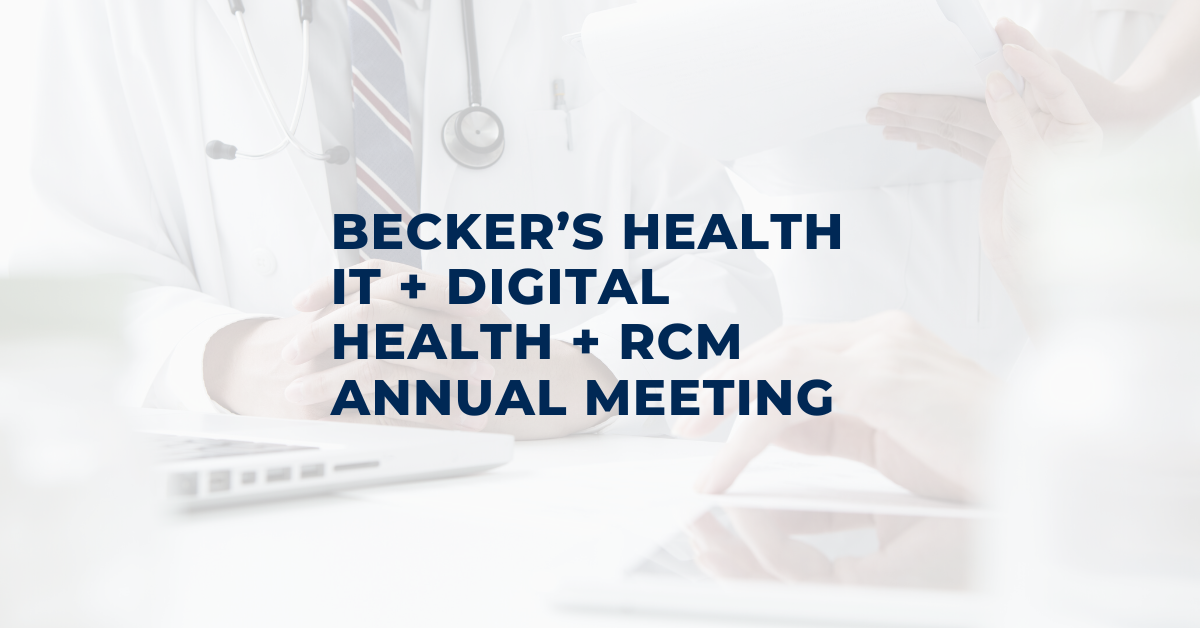The 7th Annual Becker’s Health IT, Digital Health, and RCM Meeting is complete, but the insight has carried over into our workplaces as we prepare for 2023. The focus was on the future of business and clinical technologies – an area where hospitals and health systems can often see either a positive impact on cost and care or massive operational disruption.
Here are our four key takeaways from what we learned…
- Telehealth is No Longer Optional
Telehealth isn’t a new approach to healthcare. It’s been around for decades, but since the start of the COVID-19 pandemic, patients and clinicians have seen how beneficial it can be. Telehealth was previously only a temporary offering for many hospitals and primary care facilities. However, 55 percent of patients said they were more satisfied with telehealth/virtual care visits than with in-person appointments.
As new competition arises from big companies like Walmart, Amazon, CVS, and Walgreens – which have all entered the healthcare industry with telehealth capabilities – telehealth is critical in meeting patients’ expectations.
All health systems can implement telehealth, but it takes intentional strategy to execute it well. You must make it clear and easy for patients to qualify while making it seamless for patients to use. Telehealth also has the potential to reduce costs through better outcomes while providing a solution to growing staffing issues.
- Technology Challenges
Technology can feel like a burden to physicians, especially if the technology disrupts their workflow. Making physicians feel empowered with the right technology is the key to getting the most value out of the tools while making the lives of physicians easier.
When implementing new technology, it’s crucial to engage clinical staff in the process. Making sure they are open to absorbing change is essential and can make the implementation and training seamless. It’s also important to consider the increase in temporary staff and how that can create a learning gap with different technologies. You must do what you can to meet staff needs and train accordingly.
Technology can be beneficial in solving issues like staffing, revenue, and patient experience, but choosing the right technology can be challenging. Health systems can ensure they implement the right technology by choosing a solution that aligns with your organizational goals.
- Data in the Right Places
More health systems are transitioning to the cloud which offers data management and storage benefits, cybersecurity, and more. But it can also create friction with applications and technologies that aren’t integrated with the EHR.
Speaking of the EHR, there is still a lack of analytics/real-time data available in the EHR, and 80% of EHR users say the lack of data increases stress and burnout. With physician burnout being a significant problem in healthcare today, there is a massive opportunity for hospitals to make improvements.
This can be done by taking the initiative to improve physicians’ workflow by providing patient-specific data in the EHR. Currently, in many health systems, physicians have to navigate multiple pages to get the patient data needed, which can be time-consuming and frustrating. By putting data into the physician’s hands in the EHR, you’re empowering them to provide better care efficiently.
- Workforce Retention
The workforce issues throughout the industry aren’t a secret. Everyone is facing staffing challenges, especially clinicians who have been in short supply for a while, and there’s no perfect solution or end in sight. However, there are a few things hospitals can do to decrease the effect of understaffing in certain departments.
Creating transparent career paths in-house can be an effective way to retain and attract talent. This can be done by creating an earn-while-you-learn program that allows entry-level employees to gain certifications that will lead to a new role within the organization.
It’s not just clinicians… many health systems have had difficulty hiring and retaining IT talent. As a result, hospitals can benefit from promoting from within and providing in-house training as needed.
Anywhere that you lack human capital provides an opportunity for technology to fill in the gaps or rethink the whole process. Technology can help implement new, more efficient workflows to compensate for understaffing. With technology, tasks can be automated, and workflows can be streamlined to do more with fewer staff. In healthcare, rarely is technology replacing clinicians. The goal is for technology to make your clinicians’ lives easier and remove unnecessary burdens.









